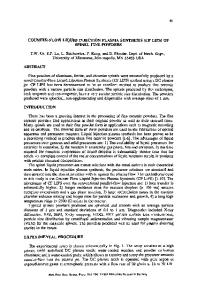Plasma Synthesis of Fine Ceramic Powders by a Novel Counter-Flow Liquid Injection Method
- PDF / 1,943,934 Bytes
- 4 Pages / 420.48 x 639 pts Page_size
- 43 Downloads / 386 Views
PLASMA SYNTHESIS OF FINE CERAMIC POWDERS BY A NOVEL COUNTER-FLOW LIQUID INJECTION METHOD. P. Kong, T.W. Or, L. Stachowicz and E. Pfender. Center for Plasma-Aided Manufacturing, Dept. of Mech. Eng., University of Minnesota, Minneapolis, MN 55455, USA. ABSTRACT Ceramic powders of carbides, oxides, solid solutions of oxides, magnetic and non-magnetic spinels, superconductors and composites have been successfully synthesized in a thermal plasma jet reactor using a novel counter-flow liquid injection plasma synthesis (CF LIPS) method developed to overcome the problems associated with solid injection and to realize the benefits of gas phase reactions and counter-flow injection. Standard material characterization techniques have been used for powder analysis. INTRODUCTION Liquid Injection Plasma Synthesis (LIPS) has been developed for achieving the benefits of gas phase reactions and avoiding the problems associated with powder injection. Although gaseous precursors are preferable they are severely limited for metals. LIPS offers a number of significant advantages over solid injection plasma synthesis: (1) The availability of liquid precursors for ceramics is extensive; (2) The reaction is essentially gas phase, fast and complete; (3) The time required for complete evaporation of liquid droplets is substantially shorter than for solids; (4) Complete control of the molar concetrations of liquid reactants results in products with precise chemical compositions. There are two types of LIPS, the parallel-flow [1,2] and counter-flow injection [3,4,5,6]. A new approach, the counter-flow LIPS, provides additional advantages over the parallel-flow LIPS method: (1) The heat transfer between the plasma and the liquid droplets is substantially higher due to the higher relative velocities between droplets and the plasma; (2) The residence time for the liquid droplets in plasma is much longer (>lOOms). This ensures complete evaporation of the liquid precursors, i.e. a gas phase reaction; (3) Large recirculation zones are observed in the reactor which is important for particle size control; (4) Long high temperature ridges (>>2500K) exist in the reactor. EXPERIMENTAL PROCEDURE The experimental setup for the counter-flow LIPS reactor is shown schematically in Fig. 1. The reactor consists of a high power, swirl stabilized DC plasma torch operated with Ar at atmospheric pressure. The typical power input for pure Ar plasma ranges from 9 to 30 TORCH GAS
SWIRL GAS PRECURSOR
MIST
WATERCOOLED TUBE OUARTZ
COONTER INJECTION
WATERCOOLED COLLECTION CHAMBER
Fig. 1 DC counter-flow LIPS reactor and its operation. Mat. Res. Soc. Symp. Proc. Vol. 180. t1990 Materials Research Society
850
kW and increases to higher values if diatomic gases are added to the main flow. Precursors together with atomizing gases are injected against the plasma flow for vaporization. A well defined stagnation region is formed at the confluence of the two flows as shown in Fig. 1. At the outflow of the confluence fine particles nucleate from the supersaturated vapor. P
Data Loading...











